Francesco Tudisco
University of Strathclyde
Graph-Convolution-Beta-VAE for Synthetic Abdominal Aorta Aneurysm Generation
Jun 16, 2025Abstract:Synthetic data generation plays a crucial role in medical research by mitigating privacy concerns and enabling large-scale patient data analysis. This study presents a beta-Variational Autoencoder Graph Convolutional Neural Network framework for generating synthetic Abdominal Aorta Aneurysms (AAA). Using a small real-world dataset, our approach extracts key anatomical features and captures complex statistical relationships within a compact disentangled latent space. To address data limitations, low-impact data augmentation based on Procrustes analysis was employed, preserving anatomical integrity. The generation strategies, both deterministic and stochastic, manage to enhance data diversity while ensuring realism. Compared to PCA-based approaches, our model performs more robustly on unseen data by capturing complex, nonlinear anatomical variations. This enables more comprehensive clinical and statistical analyses than the original dataset alone. The resulting synthetic AAA dataset preserves patient privacy while providing a scalable foundation for medical research, device testing, and computational modeling.
Approximation properties of neural ODEs
Mar 19, 2025Abstract:We study the approximation properties of shallow neural networks whose activation function is defined as the flow of a neural ordinary differential equation (neural ODE) at the final time of the integration interval. We prove the universal approximation property (UAP) of such shallow neural networks in the space of continuous functions. Furthermore, we investigate the approximation properties of shallow neural networks whose parameters are required to satisfy some constraints. In particular, we constrain the Lipschitz constant of the flow of the neural ODE to increase the stability of the shallow neural network, and we restrict the norm of the weight matrices of the linear layers to one to make sure that the restricted expansivity of the flow is not compensated by the increased expansivity of the linear layers. For this setting, we prove approximation bounds that tell us the accuracy to which we can approximate a continuous function with a shallow neural network with such constraints. We prove that the UAP holds if we consider only the constraint on the Lipschitz constant of the flow or the unit norm constraint on the weight matrices of the linear layers.
Efficient Sparsification of Simplicial Complexes via Local Densities of States
Feb 11, 2025Abstract:Simplicial complexes (SCs), a generalization of graph models for relational data that account for higher-order relations between data items, have become a popular abstraction for analyzing complex data using tools from topological data analysis or topological signal processing. However, the analysis of many real-world datasets leads to dense SCs with a large number of higher-order interactions. Unfortunately, analyzing such large SCs often has a prohibitive cost in terms of computation time and memory consumption. The sparsification of such complexes, i.e., the approximation of an original SC with a sparser simplicial complex with only a log-linear number of high-order simplices while maintaining a spectrum close to the original SC, is of broad interest. In this work, we develop a novel method for a probabilistic sparsifaction of SCs. At its core lies the efficient computation of sparsifying sampling probability through local densities of states as functional descriptors of the spectral information. To avoid pathological structures in the spectrum of the corresponding Hodge Laplacian operators, we suggest a "kernel-ignoring" decomposition for approximating the sampling probability; additionally, we exploit error estimates to show asymptotically prevailing algorithmic complexity of the developed method. The performance of the framework is demonstrated on the family of Vietoris--Rips filtered simplicial complexes.
Rethinking Oversmoothing in Graph Neural Networks: A Rank-Based Perspective
Feb 07, 2025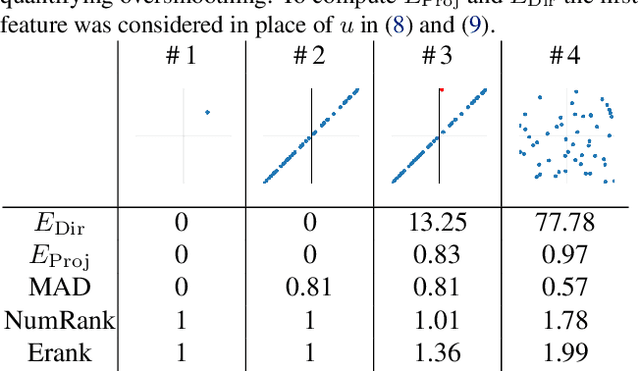

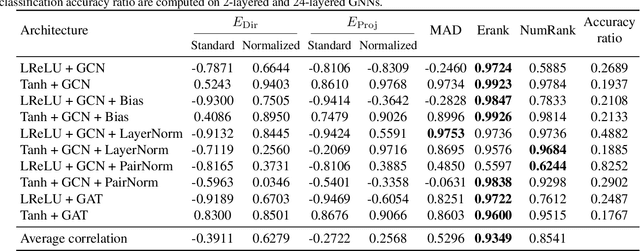
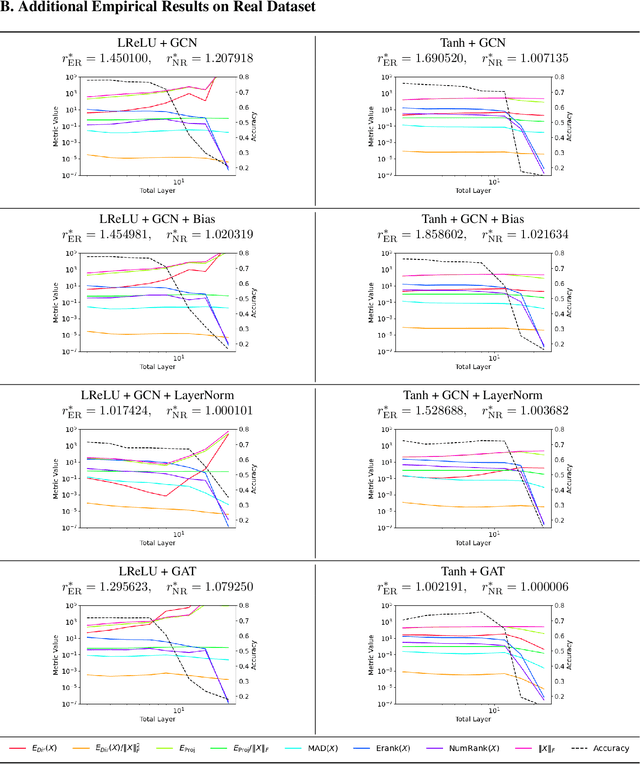
Abstract:Oversmoothing is a fundamental challenge in graph neural networks (GNNs): as the number of layers increases, node embeddings become increasingly similar, and model performance drops sharply. Traditionally, oversmoothing has been quantified using metrics that measure the similarity of neighbouring node features, such as the Dirichlet energy. While these metrics are related to oversmoothing, we argue they have critical limitations and fail to reliably capture oversmoothing in realistic scenarios. For instance, they provide meaningful insights only for very deep networks and under somewhat strict conditions on the norm of network weights and feature representations. As an alternative, we propose measuring oversmoothing by examining the numerical or effective rank of the feature representations. We provide theoretical support for this approach, demonstrating that the numerical rank of feature representations converges to one for a broad family of nonlinear activation functions under the assumption of nonnegative trained weights. To the best of our knowledge, this is the first result that proves the occurrence of oversmoothing without assumptions on the boundedness of the weight matrices. Along with the theoretical findings, we provide extensive numerical evaluation across diverse graph architectures. Our results show that rank-based metrics consistently capture oversmoothing, whereas energy-based metrics often fail. Notably, we reveal that a significant drop in the rank aligns closely with performance degradation, even in scenarios where energy metrics remain unchanged.
Solaris: A Foundation Model of the Sun
Nov 25, 2024Abstract:Foundation models have demonstrated remarkable success across various scientific domains, motivating our exploration of their potential in solar physics. In this paper, we present Solaris, the first foundation model for forecasting the Sun's atmosphere. We leverage 13 years of full-disk, multi-wavelength solar imagery from the Solar Dynamics Observatory, spanning a complete solar cycle, to pre-train Solaris for 12-hour interval forecasting. Solaris is built on a large-scale 3D Swin Transformer architecture with 109 million parameters. We demonstrate Solaris' ability to generalize by fine-tuning on a low-data regime using a single wavelength (1700 {\AA}), that was not included in pre-training, outperforming models trained from scratch on this specific wavelength. Our results indicate that Solaris can effectively capture the complex dynamics of the solar atmosphere and transform solar forecasting.
GeoLoRA: Geometric integration for parameter efficient fine-tuning
Oct 24, 2024Abstract:Low-Rank Adaptation (LoRA) has become a widely used method for parameter-efficient fine-tuning of large-scale, pre-trained neural networks. However, LoRA and its extensions face several challenges, including the need for rank adaptivity, robustness, and computational efficiency during the fine-tuning process. We introduce GeoLoRA, a novel approach that addresses these limitations by leveraging dynamical low-rank approximation theory. GeoLoRA requires only a single backpropagation pass over the small-rank adapters, significantly reducing computational cost as compared to similar dynamical low-rank training methods and making it faster than popular baselines such as AdaLoRA. This allows GeoLoRA to efficiently adapt the allocated parameter budget across the model, achieving smaller low-rank adapters compared to heuristic methods like AdaLoRA and LoRA, while maintaining critical convergence, descent, and error-bound theoretical guarantees. The resulting method is not only more efficient but also more robust to varying hyperparameter settings. We demonstrate the effectiveness of GeoLoRA on several state-of-the-art benchmarks, showing that it outperforms existing methods in both accuracy and computational efficiency.
Low-Rank Adversarial PGD Attack
Oct 16, 2024
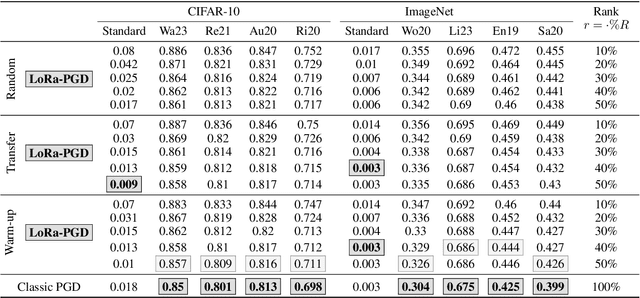


Abstract:Adversarial attacks on deep neural network models have seen rapid development and are extensively used to study the stability of these networks. Among various adversarial strategies, Projected Gradient Descent (PGD) is a widely adopted method in computer vision due to its effectiveness and quick implementation, making it suitable for adversarial training. In this work, we observe that in many cases, the perturbations computed using PGD predominantly affect only a portion of the singular value spectrum of the original image, suggesting that these perturbations are approximately low-rank. Motivated by this observation, we propose a variation of PGD that efficiently computes a low-rank attack. We extensively validate our method on a range of standard models as well as robust models that have undergone adversarial training. Our analysis indicates that the proposed low-rank PGD can be effectively used in adversarial training due to its straightforward and fast implementation coupled with competitive performance. Notably, we find that low-rank PGD often performs comparably to, and sometimes even outperforms, the traditional full-rank PGD attack, while using significantly less memory.
Subhomogeneous Deep Equilibrium Models
Mar 01, 2024Abstract:Implicit-depth neural networks have grown as powerful alternatives to traditional networks in various applications in recent years. However, these models often lack guarantees of existence and uniqueness, raising stability, performance, and reproducibility issues. In this paper, we present a new analysis of the existence and uniqueness of fixed points for implicit-depth neural networks based on the concept of subhomogeneous operators and the nonlinear Perron-Frobenius theory. Compared to previous similar analyses, our theory allows for weaker assumptions on the parameter matrices, thus yielding a more flexible framework for well-defined implicit networks. We illustrate the performance of the resulting subhomogeneous networks on feed-forward, convolutional, and graph neural network examples.
Neural Rank Collapse: Weight Decay and Small Within-Class Variability Yield Low-Rank Bias
Feb 06, 2024Abstract:Recent work in deep learning has shown strong empirical and theoretical evidence of an implicit low-rank bias: weight matrices in deep networks tend to be approximately low-rank and removing relatively small singular values during training or from available trained models may significantly reduce model size while maintaining or even improving model performance. However, the majority of the theoretical investigations around low-rank bias in neural networks deal with oversimplified deep linear networks. In this work, we consider general networks with nonlinear activations and the weight decay parameter, and we show the presence of an intriguing neural rank collapse phenomenon, connecting the low-rank bias of trained networks with networks' neural collapse properties: as the weight decay parameter grows, the rank of each layer in the network decreases proportionally to the within-class variability of the hidden-space embeddings of the previous layers. Our theoretical findings are supported by a range of experimental evaluations illustrating the phenomenon.
Robust low-rank training via approximate orthonormal constraints
Jun 02, 2023
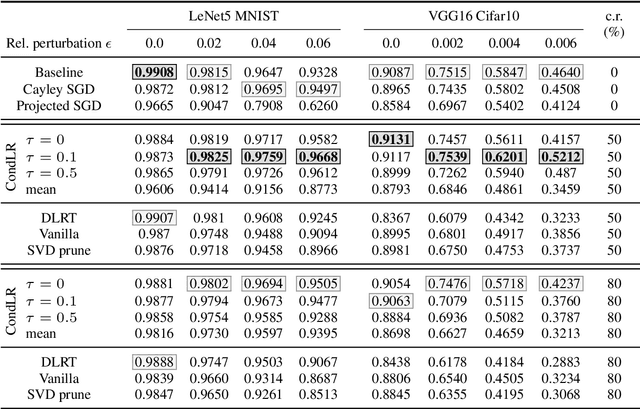

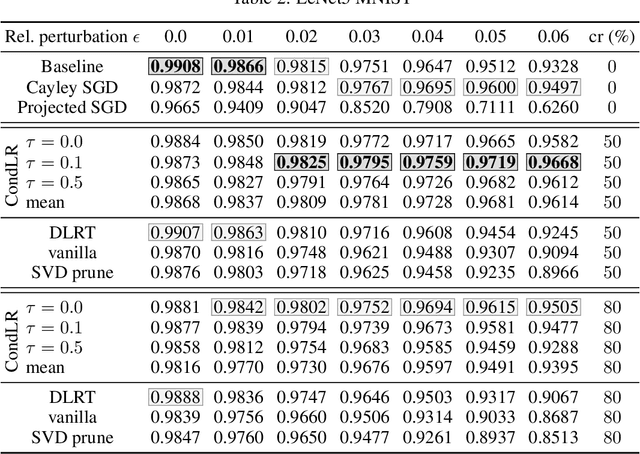
Abstract:With the growth of model and data sizes, a broad effort has been made to design pruning techniques that reduce the resource demand of deep learning pipelines, while retaining model performance. In order to reduce both inference and training costs, a prominent line of work uses low-rank matrix factorizations to represent the network weights. Although able to retain accuracy, we observe that low-rank methods tend to compromise model robustness against adversarial perturbations. By modeling robustness in terms of the condition number of the neural network, we argue that this loss of robustness is due to the exploding singular values of the low-rank weight matrices. Thus, we introduce a robust low-rank training algorithm that maintains the network's weights on the low-rank matrix manifold while simultaneously enforcing approximate orthonormal constraints. The resulting model reduces both training and inference costs while ensuring well-conditioning and thus better adversarial robustness, without compromising model accuracy. This is shown by extensive numerical evidence and by our main approximation theorem that shows the computed robust low-rank network well-approximates the ideal full model, provided a highly performing low-rank sub-network exists.
 Add to Chrome
Add to Chrome Add to Firefox
Add to Firefox Add to Edge
Add to Edge